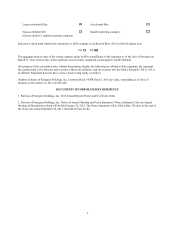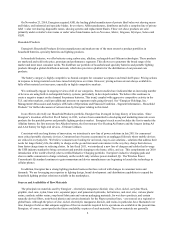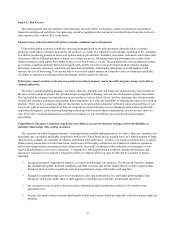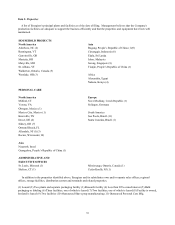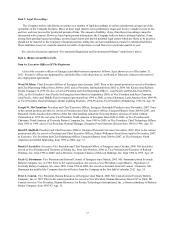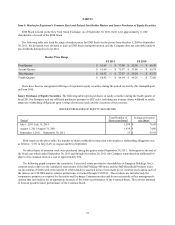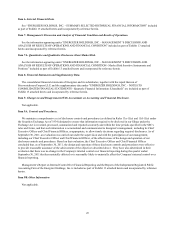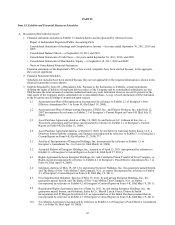Energizer 2011 Annual Report Download - page 22
Download and view the complete annual report
Please find page 22 of the 2011 Energizer annual report below. You can navigate through the pages in the report by either clicking on the pages listed below, or by using the keyword search tool below to find specific information within the annual report.relating to the handling and disposal of solid and hazardous wastes, recycling of batteries, and the remediation of contamination
associated with the use and disposal of hazardous substances. A release of such substances due to accident or an intentional act
could result in substantial liability to governmental authorities or to third parties. We have incurred, and will continue to incur,
capital and operating expenses and other costs in complying with environmental laws and regulations, including remediation
costs relating to our current and former properties and third party waste disposal sites. It is possible that we could become
subject to additional environmental liabilities in the future that could cause a material adverse effect on our results of operations
or financial condition.
The resolution of Energizer's tax contingencies may result in additional tax liabilities, which could adversely impact our
cash flows and results of operations.
Significant estimation and judgment is required in determining our provisions for income taxes in the U.S. and jurisdictions
outside the U.S. In the ordinary course of our business, there are transactions and calculations in which the ultimate tax
determination is uncertain. We are regularly under audit by tax authorities, and although we believe our tax estimates are
reasonable, the final outcome of tax audits and related litigation could be materially different than that reflected in our historical
income tax provisions and accruals. There can be no assurance that the resolution of any audits or litigation will not have an
adverse impact on future operating results.
Changes in production costs, including raw material prices, could erode Energizer's profit margins and negatively impact
operating results.
Pricing and availability of raw materials, energy, and shipping and other services needed for our business can be volatile due
to general economic conditions, labor costs, production levels, import duties and tariffs and other factors beyond our control. In
the past, substantial increases in the cost of a number of raw materials have been partially offset by price increases. However,
there is no certainty that Energizer will be able to offset future cost increases, especially given the competitive environment.
This volatility can significantly affect our production cost, and may, therefore, have a material adverse effect on our business,
results of operations and financial condition.
Energizer has a substantial level of indebtedness and is subject to various covenants relating to such indebtedness, which
limits its discretion to operate and grow its business.
Energizer's current debt level remains at almost $2.4 billion. We may be required to dedicate a substantial portion of our
cash to debt service, thereby reducing funds available to fund working capital, capital expenditures, acquisitions and
investments and other general corporate purposes. Our failure to make scheduled interest payments or to repay or refinance the
indebtedness at maturity or obtain additional financing as needed could have a material adverse effect on our business.
Additionally, many of our debt instruments are subject to certain financial and other covenants, including debt ratio tests.
We may be in breach of such covenants in the event of future declines in our operating cash flows or earnings performance,
foreign currency movements, or other unanticipated events. In the event of such breach, our lenders may be entitled to
accelerate the related debt as well as any other debt to which a cross-default provision applies, and we could be required to seek
amendments or waivers under the debt instruments or to refinance the debt. There is no assurance that we would obtain such
amendments or waivers or effect such refinancing, or that we would be able to do so on terms similar to our current debt
instruments. The covenants and financial ratio requirements contained in our debt instruments could also increase our
vulnerability to general adverse economic and industry conditions, limit our flexibility in planning for, or reacting to, changes
in our business and the markets in which we operate, place us at a competitive disadvantage as compared to our competitors
that have greater financial flexibility and limit, among other things, our ability to borrow additional funds.
Our credit ratings are important to our cost of capital.
The major credit rating agencies periodically evaluate our creditworthiness and have given us specified credit ratings. These
ratings are based on a number of factors, which include our financial strength and financial policies. We aim to maintain our
current ratings as they serve to lower our borrowing costs and facilitate our access to sources of capital on terms that we
consider advantageous to our business. Failure to maintain our credit ratings could adversely affect the interest rate in future
financings, liquidity, competitive position and access to capital markets.
Impairment of our goodwill and other intangible assets would result in a reduction in net income.
Energizer has a material amount of goodwill, trademarks and other intangible assets, as well as other long-lived assets,
which are periodically evaluated for impairment in accordance with current accounting standards. Declines in our profitability
12


